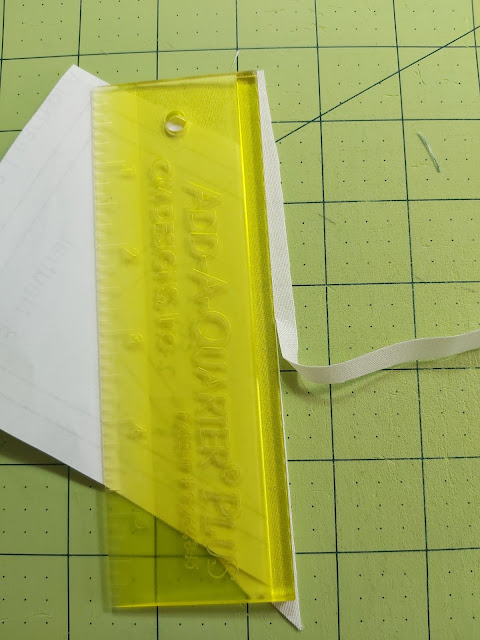First off, I have to say....this is my favourite block so far!
I hope you like it as much as I do.
At first glance I thought this block was hand-appliqued...and I worried some of you may balk at this. Then I realized it was done by machine, and I balked a bit!! I've not done much applique by machine.
Oh well, all in the name of taking one for the team, right?
So I began.
First thing is to cut 25 assorted squares @ 2" and sew them together to form a checkerboard block...
You will need to make templates for the 2 sizes of circles needed for the block. You can do them in paper and use pins to attach to your fabric ....or do like I did and use freezer paper which you can press to your fabric with a dry iron. This is what I do in all of my hand-applique.
Another idea....you can search around your kitchen for appropriately sized items to draw your circles....bowls, plates, etc. They don't even have to be exactly the right size...close is good enough!
On my copy of the pattern, the large circle was a bit cut off on the sides. No problem...I traced what I could, then rotated my freezer paper to trace the rest of the circle.
For my blue fabric I actually used the other side of a piece of Shweshwe fabric so that it would be a nice match for my block. Please don't let this confuse you...you will pin the large circle on to your background fabric RIGHT SIDE UP.
Now the fun part...machine stitch your circle on to the background using any stitch you'd like....even a regular straight stitch if you like. I chose to use one of the fancier stitches that I never get to use, just to be adventurous.
A caution here...remember to have the proper presser foot on your machine! You need to use an open foot to accommodate the wider stitches. (Unless you have chosen to do a straight stitch, of course)
If using a decorative stitch make sure your bobbin has lots of thread on it as these stitches use much more thread than your average stitch and it would be a pain to run out of bobbin while stitching the circle.
Now the scary part...flip your block over and cut away the background fabric from the inside of the circle, taking care not to cut through your appliqued circle. If you do, don't worry, you aren't the first!!! (Yes, this has happened to me before!).
...I used the fold lines on my template to help me centre the template onto the 25-patch.
Place the circle on to the block...
.....which I actually liked better. One of those happy accident moments. Play around with yours and see what you like best.
Once you have it placed to your liking, pin it down and applique it in place. You can use the same decorative stitching as before, or a different one...up to you. You can see here that I had my trusty stiletto in use. This helped me to make sure the seams of the pieced circle stayed flat and behaved themselves. I have to say, once you get used to using a stiletto you are never without it. I did not take it with me on a retreat once and I couldn't get over how much I was reaching for it. I wasn't aware of how much I actually use my stiletto without even realizing it.
Once the stitching is done, flip your block over and remove the excess fabric from behind...which is my blue fabric.
A side note...you can think ahead to how this will be quilted. If it's to be quilted by hand, then it is preferable to do the cutting of the excess layers. If it will be quilted by a longarm, the added layers won't be a problem if you choose to leave them. I really can't comment on how it would work on a domestic machine.
All that's left to do is take your threads to the back and bury them and your block is complete!
I hope you liked making this block as much as I did.
So, this quilt pattern has 12 blocks but we are going to be working on them in only 10 months. You will be getting a second block this month...I'd say two weeks from now on February 22nd. I figured it would be best to squeeze it in now as most of us are currently stuck at home.
You can find the instructions HERE
Remember to post your block on Instagram with the hashtag #tqgmodernbom so we can all see your lovely work. Maybe even include a second picture of all of your blocks together so we can see how it's going?
Have fun....and remember, if you have questions you can always contact me at sandra.croley@gmail.com.
































































